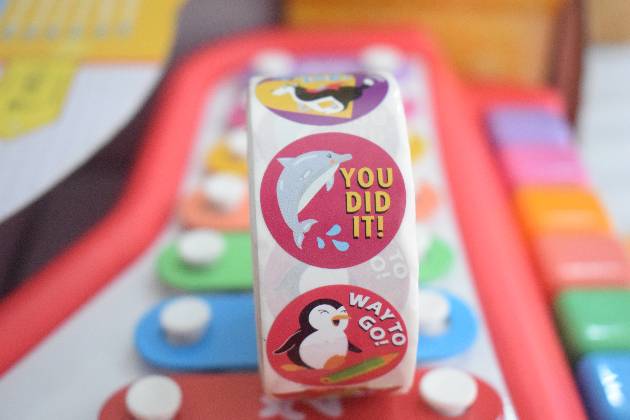Parenting is hard work, especially when kids won’t do as you ask. You don’t want to shout or make threats, but frustration often wins out. This is where positive reinforcement can be a game-changer. It’s a tool that not only helps kids to think before they do something, but it also reinforces the behavior you want from them. Here’s how it works.
What is positive reinforcement?
Positive reinforcement is a strategy that focuses on changing specific behaviors with positive consequences rather than negative ones. This means something is given to a child (praise, stickers, money) rather than something being taken away (screen time, rewards or toys). The aim is to encourage positive behavior rather than punish bad behavior so that a child leans towards doing the right thing.
For example, you tell your child if they tidy their room (the behavior), you will go to the park (the reinforcer and reward). Knowledge of this reward then makes the behavior more likely to occur and reoccur. By comparison, threatening to throw all their toys away if they don’t tidy up their room makes the behavior more unlikely as your child knows you’re unlikely to do that, or is angry with you for threatening to do so.
What are the 4 types of positive reinforcement?
There are four types of positive reinforcers:
-
Natural. These reinforcers happen naturally. So a child revises hard and does well in exams, which results in high marks and praise.
-
Tangible. These are physical reinforcers like cash or sweets or a special day out in response to them doing as you ask.
-
Social. Praise and compliments from others, such as teachers, friends, or an employer, act as a reinforcer for the behavior.
-
Token. These are given for certain behaviors and can be exchanged. A reward chart, for example. The child earns stickers for chores so they can save up and exchange them for a physical reward.
Examples of positive reinforcements for kids
Positive reinforcement doesn’t just have to be for best behavior. It can be for effort, following rules, or even just remembering to do things. There are so many ways to reward your kids. Try any or all of the following:
Extra privileges
This can be anything from later bedtimes to more screen time, having a friend over, or choosing what to have for dinner.
Spoken praise
Never underestimate this one. Praising kids and telling others, like grandparents, how well they have done helps kids thrive.
Non-verbal praise
A hug, a smile or a high five can be powerful ways to show your child you’re impressed by them.
Cash rewards
Paying your kids for doing chores/behavior can motivate them, as well as help teach them valuable money management skills around the importance of work and earning.
Descriptive praise
This works well for teens and is about telling them what you like about their behavior. For instance, ‘You were an excellent friend to help X when they were upset.” Teens can find descriptive praise a more genuine reinforcer than just being told ‘well done’.
How can rewards be linked to behavior?
How we respond to a child’s behavior makes that behavior more or less likely to happen again. This is known as operant conditioning. When a behavior is paired repeatedly with a reward, an association forms to create new behavior. For example, a child is more likely to tidy their room and go to bed on time if they know it will benefit them somehow. This means rewards can help your child do more of what you want them to do.
Related: How to create an effective reward system for kids, Reward system ideas for kids and teens
Examples of behaviors to reinforce
-
Going to bed on time (behavior) means a later bedtime at the weekend (reinforcer).
-
Getting on with siblings (behavior) means your child will get extra screen time (reinforcer).
-
Doing chores (behavior) means getting paid (reinforcer).
-
Doing their homework on time (behavior) means getting recognition for effort from a teacher or parent (reinforcer).
-
Revising for tests (behavior) means getting good results and praise (reinforcer).
-
Getting home on time (behavior) means being allowed out more often (reinforcer).
-
Tidying their room (behavior) means getting something new for their room (reinforcer).
-
Sharing toys and devices (behavior) means being allowed to keep something to themselves (reinforcer).
-
Picking up their clothes (behavior) means being allowed new clothes (reinforcer).
-
Being a good friend (behavior) means having their friend and family acknowledge this (reinforcer).
-
Making good decisions when out with friends (behavior) means being trusted to have more freedom (reinforcer).
-
Listening to you (behavior) means being able to choose a family day out (reinforcer).
What’s the difference between positive and negative reinforcement?
Positive reinforcement is a behavior strengthened by a reinforcer such as praise. Negative reinforcement takes something away when the wrong behavior is shown. For example, a child is allowed more screen time for doing their chores. This equals positive reinforcement. A child knows they will lose screen time if chores are not done. This is negative reinforcement.
When should a reinforcement schedule be used?
If you’re having constant arguments about homework, chores, and listening, a reinforcement schedule can help. What’s important to remember is to be consistent, be clear about expectations, and don’t overuse rewards or give rewards your child doesn’t value. Some children don’t appreciate extra screen time, but they may want extra time with you. Others don’t care about good marks but will be motivated to study if there is a tangible reward. You know your child best, so choose the reinforcer accordingly.
Are there any negatives to positive reinforcement?
One of the negatives of positive reinforcement is that it can feel akin to bribery. You may also believe that children should listen and do things without the lure of a reward. If so, it’s worth knowing that reinforcement and bribery differ. Reinforcement is set before something happens, whereas bribery is a reactive negotiation during challenging behavior.
We’ve all been there with bribes, especially when we want a type of behavior to stop immediately. The problem is bribes are a reaction to frustration, and they put your child in control, telling them if they misbehave, you’ll give them something to keep them quiet.
By comparison, positive reinforcement incentivizes you to do what you know is right. For example, your teen goes out with friends and has a curfew of 9 pm. They know you’ll let them go out again if they get home on time, so they’re incentivized to do the right thing.
As for having to do things without a reward, it’s worth remembering that even as adults, we don’t often do this. We work to get paid (reinforcer), clean our house so we can have a tidy space (reinforcer), and maybe even concede an argument for the sake of a relationship (reinforcer).
That said, while positive reinforcement is a great tool, it’s not always applicable. Every child and situation is different. Sometimes, depending on what’s happening and your child's age, taking things away works better as a reinforcer. Ultimately, you know your child best, so it’s always your decision as to how and when you use it.
How can GoHenry help?
A prepaid kids debit card like GoHenry can help with positive reinforcement in a number of ways. With the app you can set a range of tasks and chores from doing homework to reading every day, or create your own task, adding how much they will be rewarded for it and whether this task is daily, weekly or a one-off. This is a great way to manage a positive reinforcement schedule.















